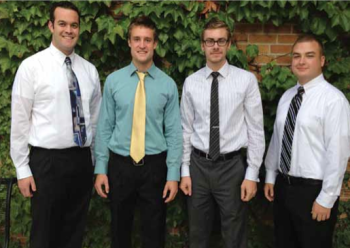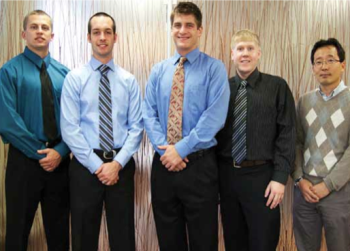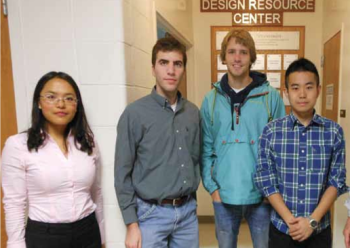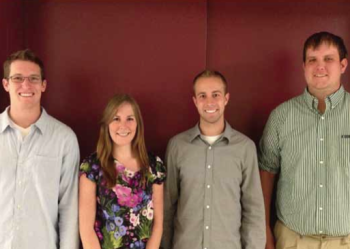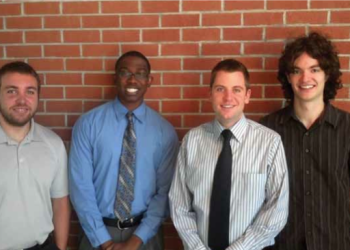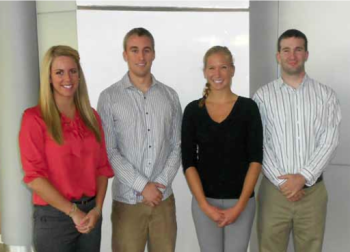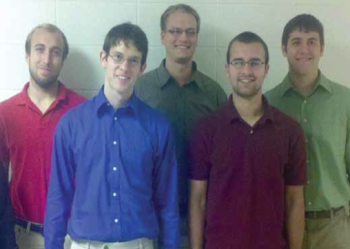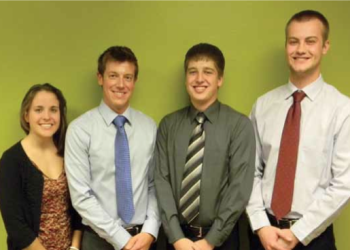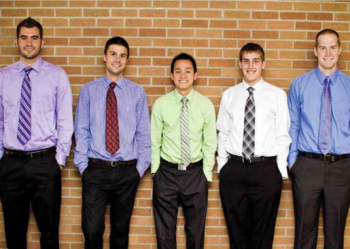Mechanical Engineering
Projects
One goal of the MSU Mechanical Engineering Program is to educate engineers who are prepared to lead, create, and innovate as their professional or graduate careers evolve. The Mechanical Engineering Design Program is the key element of the curriculum that supports this goal. There are five required design courses in the program which provide our students with eight hands-on, team-based, ‘design, test and build’ projects, and numerous opportunities to practice and refine their written, oral, poster, and video presentation skills. The Design Program in Mechanical Engineering has attracted national recognition on many occasions and helps to distinguish the ME program as one of the best in the country.
For information on becoming a project sponsor, please contact Mike Colucci.
The following are the project sponsors and projects for Fall 2012:
Ford Motor Company: Diesel Fuel Injection System
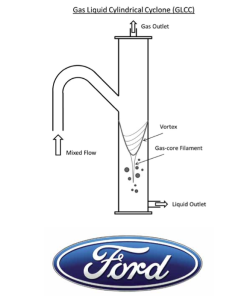 Ford Motor Company is one of the world’s leading automobile manufacturers. A significant number of its vehicles are powered by Diesel engines, which are growing in popularity because of the higher efficiencies at which they operate. When Diesel fuel is added to fuel tanks, it usually contains a significant number of dissolved air bubbles. This fuel is then pumped to the common rail that feeds the fuel injectors at high pressures, as high-pressure fuel injection allows precise control of combustion in the engine. However, dissolved air impedes the delivery of Diesel fuel to the injectors at high pressures, making it imperative that it be removed.
Ford Motor Company is one of the world’s leading automobile manufacturers. A significant number of its vehicles are powered by Diesel engines, which are growing in popularity because of the higher efficiencies at which they operate. When Diesel fuel is added to fuel tanks, it usually contains a significant number of dissolved air bubbles. This fuel is then pumped to the common rail that feeds the fuel injectors at high pressures, as high-pressure fuel injection allows precise control of combustion in the engine. However, dissolved air impedes the delivery of Diesel fuel to the injectors at high pressures, making it imperative that it be removed.
The MSU team is exploring how different kinds of compact filtration devices can be used to remove air from Diesel fuel. A prototype testing rig has been developed and will be used to assess the effectiveness of different designs of filtration systems, from which an optimal system will be chosen.
Chrysler Group LLC: Retractable Seat Insert for Comfor
 The Seat Engineering group at Chrysler LLC is interested in the development of a concept for a retractable seat insert which permits enhanced seat adjustability. Some individuals prefer firm seats, while others prefer a softer feel. The ability of customers to make their own choice of seat firmness provides a competitive advantage in the automotive industry, allowing people of different physical stature and expectations to adjust their seating for optimal comfort.
The Seat Engineering group at Chrysler LLC is interested in the development of a concept for a retractable seat insert which permits enhanced seat adjustability. Some individuals prefer firm seats, while others prefer a softer feel. The ability of customers to make their own choice of seat firmness provides a competitive advantage in the automotive industry, allowing people of different physical stature and expectations to adjust their seating for optimal comfort.
The MSU design team studied several current research concepts in seat design to determine the features of a seat that are of the most importance to the majority of passengers. The three most important parameters were found to be: fit; feel; and support; and are considered at each stage in the process of designing a seat insert to optimize the passenger’s experience. By using CAD software and 3D models, the team was able to gain a better understanding of the seat’s mechanics and thereby improve the functionality of the design. The expected outcome is a prototype seat which offers a broad range of adjustability and is applicable to the entire range of seating, from sport to luxury.
Rober Bosch, LLC: Test Rig for Analysis of Diesel Injector Spray
 Bosch is one of the world’s leading manufacturers of automotive components, which include solenoid and piezo-electric fuel injectors. When fuel is injected into engine cylinders as a spray, the shape of the spray and the distribution of droplets within it can have a significant effect on the subsequent combustion, and thus on the performance of the engine. It is therefore important to ensure that sprays produced by fuel injectors take the desired shape and distribute fuel droplets of the desired size, prior to installation in engines. Since poor fuel-spray patterns can result from imperfections in the design and manufacturing of injectors, it is useful to have a test rig with which fuel- spray patterns can be observed and analyzed. Such rigs are also useful for developing injectors with improved and optimized fuel-spray patterns.
Bosch is one of the world’s leading manufacturers of automotive components, which include solenoid and piezo-electric fuel injectors. When fuel is injected into engine cylinders as a spray, the shape of the spray and the distribution of droplets within it can have a significant effect on the subsequent combustion, and thus on the performance of the engine. It is therefore important to ensure that sprays produced by fuel injectors take the desired shape and distribute fuel droplets of the desired size, prior to installation in engines. Since poor fuel-spray patterns can result from imperfections in the design and manufacturing of injectors, it is useful to have a test rig with which fuel- spray patterns can be observed and analyzed. Such rigs are also useful for developing injectors with improved and optimized fuel-spray patterns.
Bosch currently has advanced test rigs in Europe for spray pattern visualization, which are expensive, complicated to operate, and are not practical to use at their Farmington Hills facility. Instead, Bosch would like a simpler, low-cost rig for visualizing fuel-spray patterns that can be mounted on an existing hydraulic test bench, which supplies high pressure fuel to the injector and provides the electrical signal for activating the injector. The purpose of this project is to design a prototype low-cost rig that can be used to quickly check the quality of the spray produced by any Bosch injector.
United States Steel – Great Lakes Works: Automated Measurement of Pipe Inner Diameters
 United States Steel Corporation is the largest integrated steel producer in the U.S. with an annual raw steelmaking capability of 29.3 million net tons. The company produces steel tubular and sheet products for the appliance, automotive, construction, container, gas, and oil industries. US Steel requires a device to measure the inner dimensions of pipes to ensure that their diameter, ovality, and straightness meet quality control standards.
United States Steel Corporation is the largest integrated steel producer in the U.S. with an annual raw steelmaking capability of 29.3 million net tons. The company produces steel tubular and sheet products for the appliance, automotive, construction, container, gas, and oil industries. US Steel requires a device to measure the inner dimensions of pipes to ensure that their diameter, ovality, and straightness meet quality control standards.
The steel tubes range from 2.375” to 3.5” in outside diameter and from 28 to 34 feet in length. The MSU team is looking into smart techniques for gauging pipe inner diameters that avoid the manual use of mandrels, such as designing a simple robot to conduct this task. A successful
design will ensure that pipe quality standards are measured with increased safety and reduced equipment costs, maintenance costs and manpower requirements.
Williams International, LLC: Design of a Quieter Test-Cell Air Intake
 Williams International is an aerospace and defense company, specializing in the design and manufacturing of small gas turbine engines. These engines are tested in test cells, the noise from which Williams is interested in minimizing. Williams’ facility engineers have identified the air intakes positioned on top of a recently constructed test cell as a likely source of noise. The intakes are truss-supported, mushroom-shaped hoods, composed of aluminum sheet metal that provide protection from the weather but offer little sound absorption.
Williams International is an aerospace and defense company, specializing in the design and manufacturing of small gas turbine engines. These engines are tested in test cells, the noise from which Williams is interested in minimizing. Williams’ facility engineers have identified the air intakes positioned on top of a recently constructed test cell as a likely source of noise. The intakes are truss-supported, mushroom-shaped hoods, composed of aluminum sheet metal that provide protection from the weather but offer little sound absorption.
The goals of the MSU design team are two- fold: to identify the principal source of test- cell noise and to design a solution. Therefore the team expects to incorporate principles of sound dampening in structures and principles of energy absorption in fluid flow in a design solution. The expected outcome will be a prototype and detailed design of an intake which optimizes the facility’s efficiency and minimizes its noise leakage.
ZF Lemforder Corporation: A Tool for Ball-Joint Torque Measurement
 The ZF Group is one of the world’s largest automotive suppliers, developing and producing transmissions, steering systems, axles, and chassis components. ZF Lemforder is a subsidiary of this group that specializes in steering and suspension technology and, in particular, ball- joint and suspension-linkage testing. Ball joints are utilized in several parts of a vehicle’s chassis, where multi-axis rotation is needed, and undergo extensive testing for their friction, torque, elasticity, wear, and fatigue characteristics. ZF is interested in improving the accuracy with which the torque required to rotate ball joints during testing is measured, since this torque measurement correlates well with ball-joint service life.
The ZF Group is one of the world’s largest automotive suppliers, developing and producing transmissions, steering systems, axles, and chassis components. ZF Lemforder is a subsidiary of this group that specializes in steering and suspension technology and, in particular, ball- joint and suspension-linkage testing. Ball joints are utilized in several parts of a vehicle’s chassis, where multi-axis rotation is needed, and undergo extensive testing for their friction, torque, elasticity, wear, and fatigue characteristics. ZF is interested in improving the accuracy with which the torque required to rotate ball joints during testing is measured, since this torque measurement correlates well with ball-joint service life.
The MSU team is designing a standardized tool for measuring ball-joint torque that can be used to make consistent measurements at multiple ZF facilities. The tool has to be compatible with existing test machinery and must provide a torque reading that is not affected by changes in temperature, elevation, electrical current and time. This tool will help eliminate inconsistencies in torque measurements on ball joints manufactured at different plants and so improve the company’s manufacturing process.
Whirlpool Corporation: Ice and Water Dispensation from Refrigerator
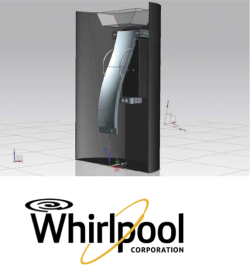 Whirlpool Corporation is one of the largest appliance-manufacturing companies in the United States and sells its products throughout the world. A number of its refrigerator models dispense both ice and water to the consumer, and Whirlpool is interested in optimizing the design of these dispensers to permit large containers to be filled from shallow dispensing wells. In designing such dispensing systems, it is most important that they be both energy-efficient and compact, so that as much interior space as possible is available for food storage.
Whirlpool Corporation is one of the largest appliance-manufacturing companies in the United States and sells its products throughout the world. A number of its refrigerator models dispense both ice and water to the consumer, and Whirlpool is interested in optimizing the design of these dispensers to permit large containers to be filled from shallow dispensing wells. In designing such dispensing systems, it is most important that they be both energy-efficient and compact, so that as much interior space as possible is available for food storage.
The MSU team will evaluate a set of dispenser designs that are customized for one of Whirlpool’s best-selling refrigerators, supported by theoretical calculations and experimental tests. A functioning prototype of the most promising design will then be built and tested for functionality and reliability. This prototype will then be delivered to Whirlpool for further evaluation.
Haworth Inc.: Design of a Movable Wall Syste
 Haworth is an architectural interior and office design company located in Holland, MI that produces a wide range of office furniture products such as moveable walls, raised floors, furniture systems, seating, and wood-case goods, while striving for and promoting environmental sustainability. Haworth’s moveable wall installations, made from materials such as glass and drywall, are designed to allow entire floor-to-ceiling walls to be taken down and reassembled in different configurations in a short amount of time to allow offices to be adapted to meet the changing needs of a company. To increase its market share, Haworth is considering introducing a new kind of moveable wall with a surface to which papers can be pinned, tacked or stapled directly.
Haworth is an architectural interior and office design company located in Holland, MI that produces a wide range of office furniture products such as moveable walls, raised floors, furniture systems, seating, and wood-case goods, while striving for and promoting environmental sustainability. Haworth’s moveable wall installations, made from materials such as glass and drywall, are designed to allow entire floor-to-ceiling walls to be taken down and reassembled in different configurations in a short amount of time to allow offices to be adapted to meet the changing needs of a company. To increase its market share, Haworth is considering introducing a new kind of moveable wall with a surface to which papers can be pinned, tacked or stapled directly.
The goal of this project is to design a prototype pin-tackable moveable wall for office installation which meets Haworth’s expectations for durability, ease of installation and assembly, and provides a high level of aesthetic quality, that can be put into production with minimal cost and manufactured in the shortest time possible.
General Motors Foundation: Pedestrian Sound Simulator for Electric Vehicl
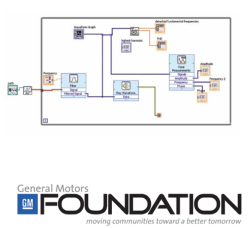 General Motors is one of the world’s leading automobile manufacturers and has been developing new hybrid electric vehicles (HEVs) for production. While HEVs have significant environmental advantages over vehicles with conventional engines, their ultra-quiet performance is of concern to particular groups such as the sight impaired and pedestrians, who are often unaware of their presence.
General Motors is one of the world’s leading automobile manufacturers and has been developing new hybrid electric vehicles (HEVs) for production. While HEVs have significant environmental advantages over vehicles with conventional engines, their ultra-quiet performance is of concern to particular groups such as the sight impaired and pedestrians, who are often unaware of their presence.
The MSU design team is developing a computer- based program that will permit General Motors designers and engineers to design the sound of electric hybrid vehicles of the future. Its goal is to create a computer program with a graphical user interface that will enable the user to modify and fine-tune the sound signatures (e.g. frequency and pitch) that are emitted for different inputs. For example, if the throttle position is the input, the output is a sound like the acceleration of a vehicle, emitted by speakers. The sounds generated by the software should be adjustable to reproduce different vehicle sounds for different products, targeted at different customers. An additional proposed feature of this program will be a modular cockpit simulator, which will allow audio designers and engineers to test the acoustic signatures they have created and refine them as needed.
U.S. Air Force Research Laboratory : Active Cooling Control of Electrical Racks
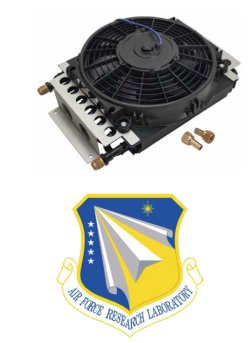 The US Air Force routinely deploys sophisticated electronic systems to remote parts of the world to support military, civilian, and humanitarian missions. Many such systems are rack-mounted electronics that may be deployed to hot, humid locations and require significant cooling heat transfer to maintain their functionality. To address this cooling need, the Air Force Research Laboratory has proposed a challenge problem: to develop an innovative ‘all- purpose’ 3ft3 equipment enclosure that can continually dissipate 2 kilowatts of power. The cooled space must be maintained between 15 and 45 oC and cannot be contaminated with outside debris or toxic chemicals (such as typical refrigerants).
The US Air Force routinely deploys sophisticated electronic systems to remote parts of the world to support military, civilian, and humanitarian missions. Many such systems are rack-mounted electronics that may be deployed to hot, humid locations and require significant cooling heat transfer to maintain their functionality. To address this cooling need, the Air Force Research Laboratory has proposed a challenge problem: to develop an innovative ‘all- purpose’ 3ft3 equipment enclosure that can continually dissipate 2 kilowatts of power. The cooled space must be maintained between 15 and 45 oC and cannot be contaminated with outside debris or toxic chemicals (such as typical refrigerants).
The MSU design team is proposing a cooling solution comprising a conventional external refrigeration system that is connected to the enclosure by a water circuit. Thermodynamic and heat transfer analyses are used to optimize the design of a prototype system, the performance of which will be tested experimentally.
